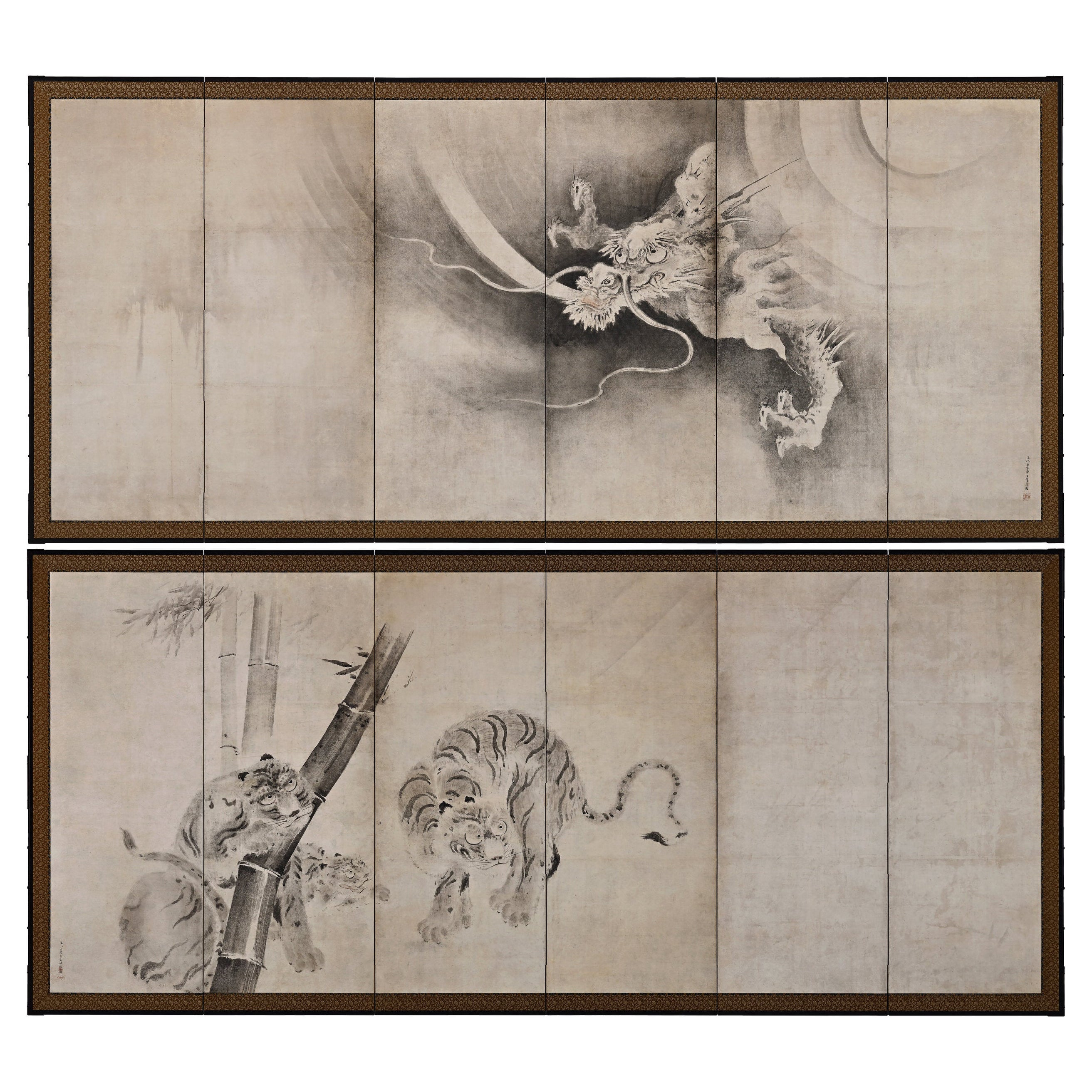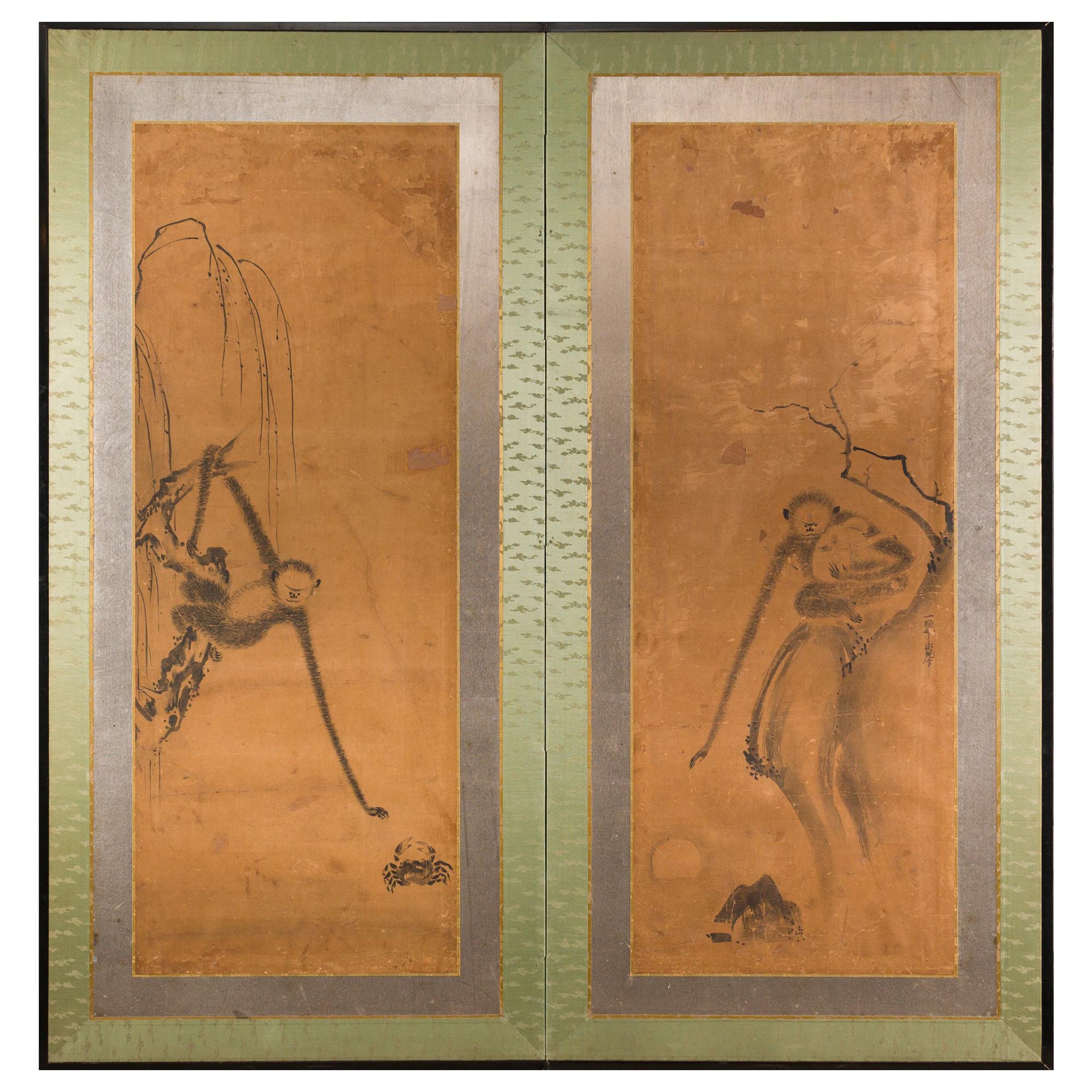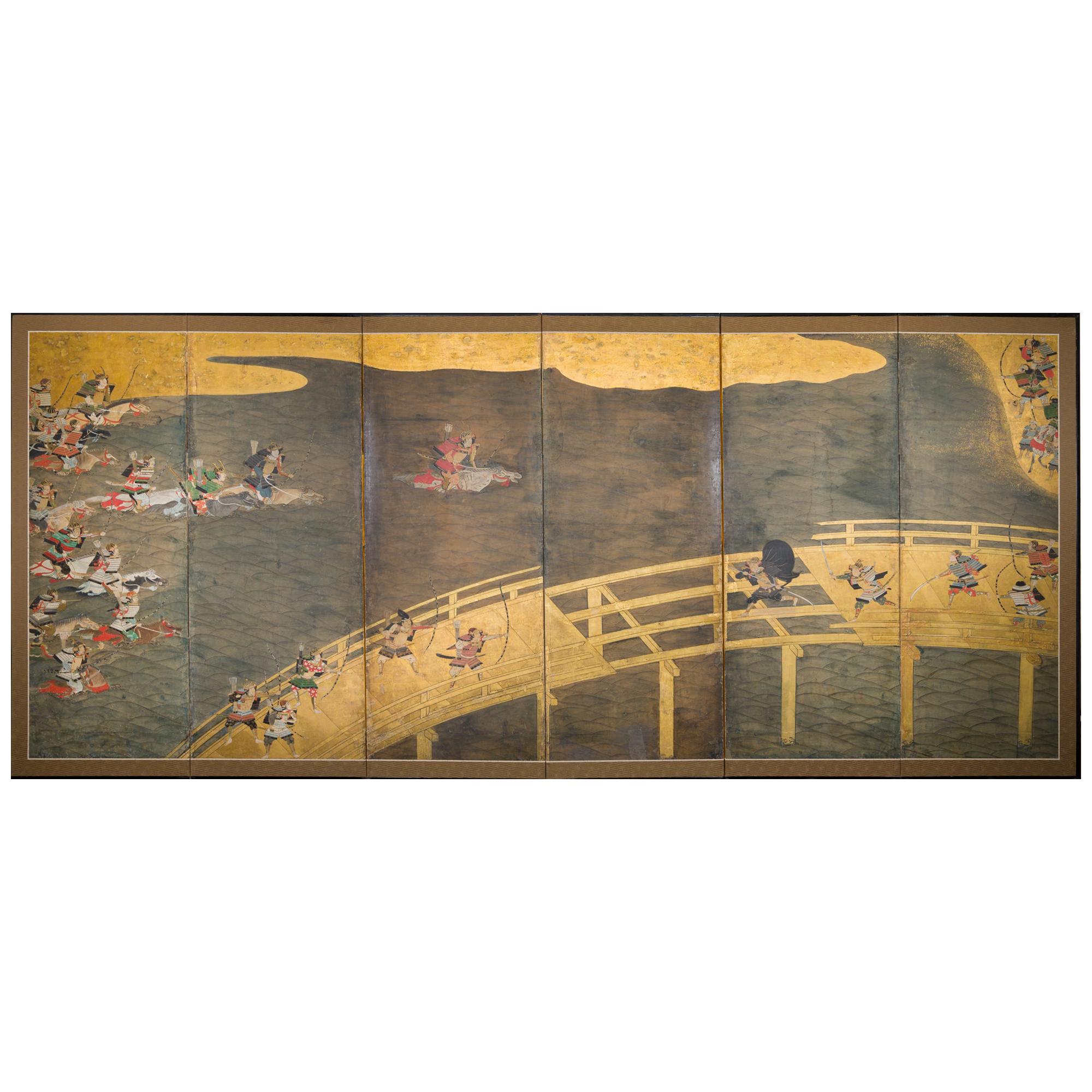Items Similar to 17th Century Japanese Screen Pair, Cranes
Want more images or videos?
Request additional images or videos from the seller
1 of 13
17th Century Japanese Screen Pair, Cranes
About the Item
Cranes
Anonymous, Kano School.
Edo period, second half of the 17th century.
Pair of six-panel screens. Ink, pigment gofun and gold leaf on paper.
Dimensions:
Each: H. 171 cm x W. 376 cm (67’’ x 148’’)
This bold and innovative composition presents a grouping of red-crowned and white-naped cranes extending across a pair of six-panel Japanese screens. The 15 cranes in this work, grouped in rhythmic arrangements, are standing along a body of water, which is only partially revealed through golden clouds. Rock formations at either end of the monumental work shelter flowering peonies and camellias, representing the seasons of summer and winter. The bold, clear and elegant forms of the cranes, tinged with humor, are set off to full effect against the large unpainted areas of the gold-leaf screens. Read from right to left there is a sense of narrative as the intermingling forms of the cranes, each one an individual and full of life, lead us through the seasons. It is the work of an anonymous painter, presumably of the Kano school, from the second half of the 17th century.
This dramatic work, spanning over 24 feet, is really an emblem of good fortune rather than a depiction of the natural world. From ancient times, cranes in Japan were said to live for a thousand years, serving as potent symbols of youthfulness and long life in both literature and art. The red-crowned crane, in particular, is an auspicious symbol of the New Year, of peace, harmony, prosperity, and fidelity.
- Dimensions:Height: 67 in (170.18 cm)Width: 148 in (375.92 cm)Depth: 0.75 in (1.91 cm)
- Sold As:Set of 2
- Style:Edo (Of the Period)
- Materials and Techniques:
- Place of Origin:
- Period:1670-1679
- Date of Manufacture:circa 1670
- Condition:Refinished. Wear consistent with age and use.
- Seller Location:Kyoto, JP
- Reference Number:1stDibs: LU2472331030392
About the Seller
5.0
Recognized Seller
These prestigious sellers are industry leaders and represent the highest echelon for item quality and design.
Established in 2001
1stDibs seller since 2016
60 sales on 1stDibs
Typical response time: 11 hours
- ShippingRetrieving quote...Ships From: Kyoto, Japan
- Return PolicyA return for this item may be initiated within 10 days of delivery.
More From This SellerView All
- 17th Century Japanese Screen Pair. Tiger & Dragon by Kaiho YusetsuLocated in Kyoto, JPKaiho Yusetsu (1598-1677) Tiger and Dragon Early Edo Period, Circa 1650 A Pair of Six-fold Japanese Screens. Ink and slight color on paper. Dimensions: Each screen: H. 171 cm x W. 380 cm (67.5’’ x 149.5’’) In this pair of early Edo period Japanese screens a group of tigers prowl in a bamboo grove whipped with fierce wind, while a dragon claws through clouds and mist. The dragon embodies elemental qualities - looming out of the mist, the coils of its body disappearing in the clouds. The dragon is calling for rain, symbolizing spring which is considered the fountain of life. On the other side, the tigers calls for the wind, symbolizing autumn which is considered the end of life. Tigers were familiar motifs within Japanese art from ancient times though the animals were imaginary to the people in the 17th century. While dragons and tigers are usually associated as sacred and ferocious, in this painting, both animals have rather amusing expressions. The tigers appear to glare at the dragon with cat-like eyes, and the look on the swirling dragon’s face appears almost affectionate - lending a playful flair to an otherwise magnificent theme. The tiger and dragon are cosmological symbols of the balancing forces in the world. Screens such as this were originally meant to express the fluctuating nature of the world. For Japanese in the early Edo period, they likely suggested the powers of the cosmos. In Japan the tiger and dragon motif was originally absorbed into the circles of Zen monasteries before spreading into the secular world. The theme especially appealed to the military classes with the Kano school, the official painters to the Shogun and the samurai, being the leading contributors. The painter of this pair of screens, Kaiho Yusetsu (1598-1677), was closely patronized by the third Shogun Tokugawa Iemitsu. In his later years he worked with Kano school artists...Category
Antique Mid-17th Century Japanese Edo Paintings and Screens
MaterialsSilk, Wood, Paper
- 17th Century Japanese Screen Pair by Soga Nichokuan, Hawks on Pine & Plum TreesLocated in Kyoto, JPHawks on plum and pine Soga Nichokuan (active circa 1625-1660) Pair of six-fold screens. Ink, mineral pigments, gofun, gold and speckled gold leaf on paper. Upper seal: H...Category
Antique 1640s Japanese Edo Paintings and Screens
MaterialsWood, Paper
- 17th Century Japanese Screen. Ink Plum Tree & Birds by Kano Naonobu.Located in Kyoto, JPKano Naonobu (1607-1650) Plum Tree and Birds Six-fold Japanese Screen. Ink and slight color on paper. In this evocative ink work spread over a six-panel folding screen, we see the consummation of the elegance and refinement of the Edo Kano school. This 17th century screen is a rare surviving example of a large-scale bird and flower painting by Kano Naonobu, the younger brother of Kano Tanyu...Category
Antique 17th Century Japanese Edo Paintings and Screens
MaterialsWood, Paper
- Circa 1700 Japanese Screen Pair, Cranes & Pines, Kyoto Kano SchoolLocated in Kyoto, JPPines and Cranes Anonymous. Kyoto Kano School. Late 17th/early 18th centuries, circa 1700. Pair of six-panel Japanese folding screens. Ink, gofun, pigment and gold leaf on paper. This bold composition presents two pine trees extending to the left and right across a gold leaf background. One tree is silhouetted against a green ground, golden clouds obscuring its true size, the other stretches across a stylized waterway. The pines are paired with Manchurian cranes with red crests and snow white plumage. Both have been highly auspicious motifs in East Asia since Chinese antiquity. Here the artist utilized fluid and instinctive ink brushstrokes to define the trunk, branches and tail feathers, in strong contrast to the precision and sharp angularity of the crane’s legs and beaks. The adoption of this vast metallic painting support required an unerring sense of design and composition, so that the negative space surrounding motifs could imply context for the otherwise floating pictorial elements. The brushwork detailing the trunks of the pines, the exaggerated dimensions of the pine trees and the strength and dynamism of the composition are all reminiscent of Kano Eitoku...Category
Antique Late 17th Century Japanese Edo Paintings and Screens
MaterialsGold Leaf
- 17th century Japanese Falcon Painting, Mitani Toshuku, Unkoku SchoolBy Mitani ToshukuLocated in Kyoto, JPMitani Toshuku (1577-1654) “Falcon” Wall panel, ink and light color on paper. Upper Seal: Mitani Lower Seal: Toshuku Dimensions: Each 118.5 cm x 51 cm x 2 cm (46.5” x 20” x .75”) Individual falcon paintings by Mitani Toshuku (1577-1654), an early artist of the Unkoku School. Founded by Unkoku Togan (1547–1618), a master of the Momoyama period, the Unkoku school enjoyed long lasting patronage in southern Japan. Togan was a retainer of the Mori family in present day Yamaguchi prefecture. Members of the school considered themselves to be in the artistic lineage of Sesshu Toyo...Category
Antique Early 17th Century Japanese Edo Paintings and Screens
MaterialsPaper
- Japanese Painting, 17th Century, Tale of Genji, Tosa SchoolLocated in Kyoto, JPIllustration to an unidentified chapter of the Tale of Genji (Genji Monogatari) Tosa School (second half of the 17th Century) Ink, pigment, gofun and...Category
Antique Late 17th Century Japanese Edo Paintings and Screens
MaterialsGold Leaf
You May Also Like
- 17th Century Japanese Two-Panel Screen, Gibbons of FolkloreLocated in Hudson, NYJapanese two-panel screen: Gibbons of Folklore, Edo period (17th century) Kano School painting of gibbons in Japanese fables. The left panel represents a Japanese fable of a monkey a...Category
Antique Late 17th Century Japanese Edo Paintings and Screens
MaterialsSilk, Wood, Paper
- Late 17th-Early 18th Century Japanese Six-Panel Screen, Battle at Uji BridgeLocated in Hudson, NYJapanese six-panel screen: Battle at Uji Bridge, the first battle at Uji was in 1180 and it marked the start of the Heike Wars. The Genji troops crossed the...Category
Antique Late 17th Century Japanese Edo Paintings and Screens
MaterialsGold Leaf
- Japanese Two Panel Screen Manchurian Crane and TurtlesLocated in Hudson, NYIn Japan, cranes symbolize fidelity as they mate for life and turtles symbolize longevity. Additionally, this screen also has the Japanese motif of sho-chiku-bai, or the three friends of winter (pine, plum, and bamboo). So called the three friends of winter because all three flourish during the cold months. This screen was originally fusuma doors...Category
Antique Mid-19th Century Japanese Edo Paintings and Screens
MaterialsPaper
- Japanese Two Panel Screen Amorous Cranes and TurtlesLocated in Hudson, NYJapanese two panel screen: Amorous Cranes and Turtles. In Japan, cranes symbolize fidelity as they mate for life and turtles symbolize longevity. Additionally, this screen also has the Japanese motif of sho-chiku-bai, or the three friends of winter (pine, plum, and bamboo). So called the three friends of winter because all three flourish during the cold months. This screen was originally fusuma doors...Category
Antique 1850s Japanese Edo Paintings and Screens
MaterialsWood, Paper
- Japanese Two-Panel Screen: Cranes on GoldLocated in Hudson, NYEarly Kano School painting of pine trees overlooking two beautifully painted cranes and floral design in a natural setting by water’s edge. Mineral pig...Category
Antique Late 18th Century Japanese Paintings and Screens
MaterialsGold, Gold Leaf
- Japanese Showa Six Panel Screen Manchurian Crane Bamboo GroveLocated in Rio Vista, CAEnchanting Japanese Showa period six-panel byobu screen titled "Bamboo Forest-Immortal Together". The large screen depicts six manchurian cranes in a ...Category
20th Century Japanese Showa Paintings and Screens
MaterialsBrass





